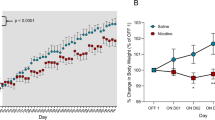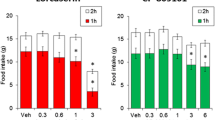Abstract
Rationale
Antipsychotic drugs, particularly the newer atypical compounds, have been associated with rapid weight gain in a clinical setting. However, there are few reported animal models producing reliable hyperphagia correlating with the human weight gain liability of these drugs.
Objective
To compare the effects of the classic neuroleptic haloperidol with the atypical antipsychotics clozapine and olanzapine on the microstructure of ingestive behaviour in rats.
Methods
Male hooded Lister rats drank a palatable high-calorie fat emulsion (10% Intralipid) during 30-min test sessions and microstructural analyses were made following administration of each drug over a range of doses.
Results
Clozapine (0.3 mg/kg) and olanzapine (0.1, 0.3, 1 mg/kg) significantly increased intake, whilst haloperidol (0.05, 0.1, 0.2 mg/kg) significantly decreased drinking. No significant changes in the latency to the first lick were observed following any of the drugs tested. Median interlick intervals showed small, dose-related increases after clozapine (3.0 mg/kg), olanzapine (0.3, 1.0 mg/kg) and haloperidol (0.1, 0.2 mg/kg). Olanzapine (1.0 mg/kg) significantly elevated the number of clusters of licking (bouts of licking separated by pauses greater than 500 ms), whilst clozapine and haloperidol did not. Mean cluster size (licks per cluster) was not affected by clozapine or olanzapine, but haloperidol (0.025, 0.05, 0.1, 0.2 mg/kg) produced marked, significant decreases in cluster size.
Conclusions
Clozapine and olanzapine increased fat intake whereas haloperidol did not, and this resembles the greater weight gain liability of atypical antipsychotics in humans. A delay or reduction of the post-ingestive satiety signal combined with preserved palatability appears to be the mechanism responsible for fat hyperphagia in rats treated with clozapine and olanzapine. Conversely, haloperidol leaves satiety unaffected but reduces the palatability of the fat emulsion resulting in reduced intake.





Similar content being viewed by others
References
Allison DB, Mentore JL, Heo M, Chandler LP, Cappelleri JC, Infante MC, Weiden PJ (1999) Antipsychotic-induced weight gain: a comprehensive research synthesis. Am J Psychiatry 156:1686–1696
Asin KE, Davis JD, Bednarz L (1992) Differential effects of the serotonergic and catecholaminergic drugs on ingestive behavior. Psychopharmacology 109:415–421
Baptista T (1999) Body weight gain induced by antipsychotic drugs: mechanisms and management. Acta Psychiatr Scand 100:3–16
Baptista T, Parada MA, Hernandez L (1987) Long-term administration of some antipsychotic drugs increases body weight and feeding in rats: are dopamine D2 receptors involved? Pharmacol Biochem Behav 27:399–405
Baptista T, Mata A, Teneud L, De Quijada M, Han HW, Hernandez L (1993) Effects of long-term administration of clozapine on body weight and food intake in rats. Pharmacol Biochem Behav 45:51–54
Basson BR, Kinon BJ, Taylor CC, Szymanski KA, Gilmore JA, Tollefson GD (2001) Factors influencing acute weight change in patients with schizophrenia treated with olanzapine, haloperidol or risperidone. J Clin Psychiatry 62:231–238
Beasley CM, Tollefson G, Tran P, Satterlee W, Sanger T, Hamilton S (1996) Olanzapine versus placebo and haloperidol: acute phase results of the North American double-blind olanzapine trial. Neuropsychopharmacology 14:111–123
Benvenga MJ, Leander JD (1997) Increased food consumption by clozapine, but not by olanzapine, in satiated rats. Drug Dev Res 41:48–50
Brown S, Birtwistle J, Roe L, Thompson C (1999) The unhealthy lifestyle of people with schizophrenia. Psychol Med 29:697–701
Clifton PG, Lee MD, Dourish CT (2000) Similarities in the action of Ro 60-0175, a 5-HT2C receptor agonist, and d-fenfluramine on feeding patterns in the rat. Psychopharmacology 152:256–267
Davis JD (1973) The effectiveness of some sugars in stimulating licking behaviour in the rat. Physiol Behav 11:39–45
Davis JD, Perez MC (1993) Food deprivation-and palatability-induced microstructural changes in ingestive behavior. Am J Physiol 264 (Reg Int Comp Physiol 33):R97–R103
Davis JD, Smith GP (1992) Analysis of the microstructure of the rhythmic tongue movements of rats ingesting maltose and sucrose solutions. Behav Neurosci 106:217–228
Dourish CT (1995) Multiple serotonin receptors: opportunities for new treatments for obesity? Obesity Res 3:449S–462S
Esel E, Basturk M, Saffet Gonul A, Kula M, Tayfun Turan M, Yabanoglu I, Sofuoglu S (2001) Effects of olanzapine and haloperidol on serum prolactin levels in male schizophrenic patients. Psychoneuroendocrinology 26:641–647
Garattini S, Mennini T, Samanin R (1989) Reduction of food intake by manipulation of central serotonin: current experimental results. Br J Psychiatry 155:41–51
Geary N, Smith GP (1985) Pimozide decreases the positive reinforcing effect of sham fed sucrose in the rat. Pharmacol Biochem Behav 22:787–790
Goodall E, Oxtoby C, Richards R, Watkinson G, Silverstone T (1988) A clinical trial of the efficacy and acceptability of d-fenfluramine in the treatment of neuroleptic-induced obesity. Br J Psychiatry 153:208–213
Howell DC (1997) Statistical methods for psychology, 4th edn. Duxbury Press, London
Kapur S, Barsoum SC, Seeman MD (2000) Dopamine D2 receptor blockade by haloperidol: 3H-raclopride reveals much higher occupancy than EEDQ. Neuropsychopharmacology 23:595–598
Kraus T, Haack M, Schuld A, Hinze-Selch D, Kuhn M, Uhr M, Pollmacher T (1999) Body weight regulation and leptin plasma levels during treatment with antipsychotic drugs. Am J Psychiatry 156:312–314
Lecklin A, Etu-Seppala P, Stark H, Tuomisto L (1998) Effects of intracerebroventricularly infused histamine and selective H1, H2 and H3 agonists on food and water intake and urine flow in Wistar rats. Brain Res 793:279–288
Lee MD, Clifton PG (1992) Partial reversal of fluoxetine anorexia by the 5-HT antagonist metergoline. Psychopharmacology 107:359–364
Lee MD, Clifton PG (2002) Meal patterns of free feeding rats treated with clozapine, olanzapine or haloperidol. Pharmacol Biochem Behav 71:147–154
Moore NA, Bymaster FP (1999) Neuropharmacological profiles of novel antipsychotic agents. In: Palomo T, Beninger RJ, Archer T (eds) Interactive monoaminergic disorders, strategies for studying brain disorders 4. Editorial Sintesis, Madrid
Remington G, Kapur S (2000) Atypical antipsychotics: are some more atypical than others? Psychopharmacology 148:3–15
Rossi R, Del Prete E, Scharrer E (1999) Effect of the H1-histamine receptor agonist betahistine on drinking and eating behaviour in pygmy goats. Physiol Behav 66:517–521
Spector AC, Klumpp PA, Kaplan JM (1998) Analytical issues in the evaluation of food deprivation and sucrose concentration effects of the microstructure of licking behaviour in the rat. Behav Neurosci 112:678–694
Stanton JM (1995) Weight gain associated with neuroleptic medication: a review. Schizophr Bull 21:463–472
Vickers SP, Dourish, CT, Kennett GA (2001) Evidence that hypophagia induced by d-fenfluramine and d-norfenfluramine in the rat is mediated by 5-HT2C receptors. Neuropharmacology 41:200–209
Ward BO, Somerville EM, Clifton PG (2000) Intraccumbens baclofen selectively enhances feeding behaviour in the rat. Physiol Behav 68:463–468
Warwick ZS, Schiffman SS (1992) Role of dietary fat in calorie intake and weight gain. Neurosci Biobehav Rev 16:585–596
Wirshing DA, Wirshing WC, Kysar L, Berisford MA, Goldstein D, Pashdag J, Mintz J, Marder SR (1999) Novel antipsychotics: comparison of weight gain liabilities. J Clin Psychol 60:358–363
Acknowledgements
A.W.H. is supported by an MRC Collaborative Studentship with Eli Lilly & Co.
Author information
Authors and Affiliations
Corresponding author
Rights and permissions
About this article
Cite this article
Hartfield, A.W., Moore, N.A. & Clifton, P.G. Effects of clozapine, olanzapine and haloperidol on the microstructure of ingestive behaviour in the rat. Psychopharmacology 167, 115–122 (2003). https://doi.org/10.1007/s00213-002-1368-8
Received:
Accepted:
Published:
Issue Date:
DOI: https://doi.org/10.1007/s00213-002-1368-8




